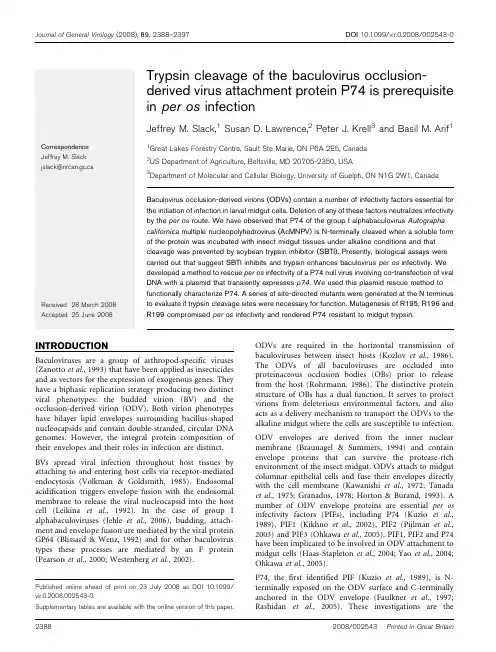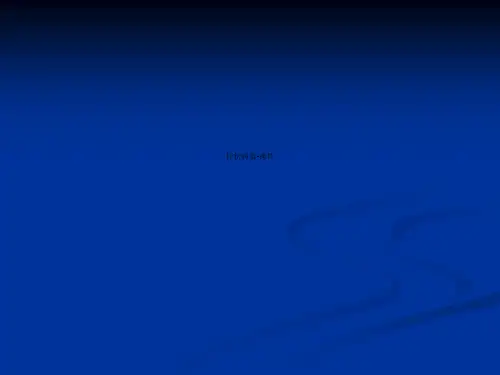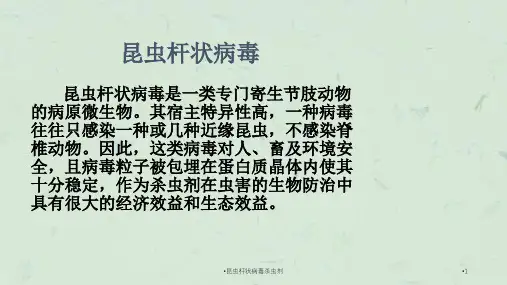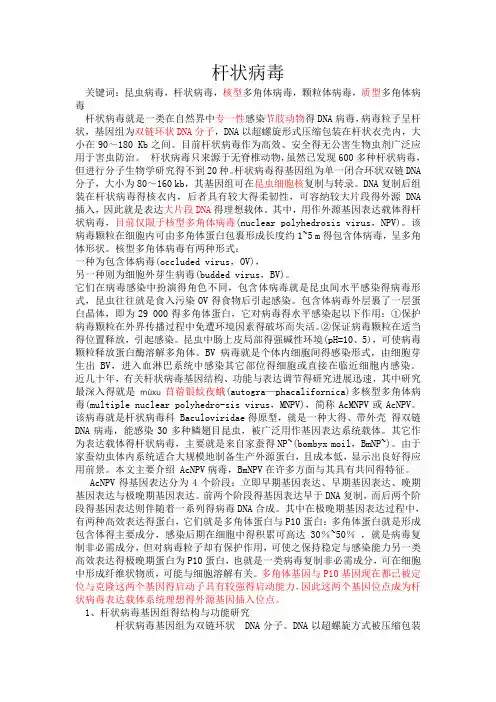杆状病毒-ppt课件
- 格式:ppt
- 大小:3.03 MB
- 文档页数:42



Trypsin cleavage of the baculovirus occlusion-derived virus attachment protein P74is prerequisite in per os infectionJeffrey M.Slack,1Susan wrence,2Peter J.Krell3and Basil M.Arif1Correspondence Jeffrey M.Slack jslack@nrcan.gc.ca 1Great Lakes Forestry Centre,Sault Ste Marie,ON P6A2E5,Canada2US Department of Agriculture,Beltsville,MD20705-2350,USA3Department of Molecular and Cellular Biology,University of Guelph,ON N1G2W1,CanadaReceived28March2008 Accepted25June2008Baculovirus occlusion-derived virions(ODVs)contain a number of infectivity factors essential for the initiation of infection in larval midgut cells.Deletion of any of these factors neutralizes infectivity by the per os route.We have observed that P74of the group I alphabaculovirus Autographa californica multiple nucleopolyhedrovirus(AcMNPV)is N-terminally cleaved when a soluble form of the protein was incubated with insect midgut tissues under alkaline conditions and that cleavage was prevented by soybean trypsin inhibitor(SBTI).Presently,biological assays were carried out that suggest SBTI inhibits and trypsin enhances baculovirus per os infectivity.We developed a method to rescue per os infectivity of a P74null virus involving co-transfection of viral DNA with a plasmid that transiently expresses p74.We used this plasmid rescue method to functionally characterize P74.A series of site-directed mutants were generated at the N terminus to evaluate if trypsin cleavage sites were necessary for function.Mutagenesis of R195,R196and R199compromised per os infectivity and rendered P74resistant to midgut trypsin.INTRODUCTIONBaculoviruses are a group of arthropod-specific viruses (Zanotto et al.,1993)that have been applied as insecticides and as vectors for the expression of exogenous genes.They have a biphasic replication strategy producing two distinct viral phenotypes:the budded virion(BV)and the occlusion-derived virion(ODV).Both virion phenotypes have bilayer lipid envelopes surrounding bacillus-shaped nucleocapsids and contain double-stranded,circular DNA genomes.However,the integral protein composition of their envelopes and their roles in infection are distinct. BVs spread viral infection throughout host tissues by attaching to and entering host cells via receptor-mediated endocytosis(Volkman&Goldsmith,1985).Endosomal acidification triggers envelope fusion with the endosomal membrane to release the viral nucleocapsid into the host cell(Leikina et al.,1992).In the case of group I alphabaculoviruses(Jehle et al.,2006),budding,attach-ment and envelope fusion are mediated by the viral protein GP64(Blissard&Wenz,1992)and for other baculovirus types these processes are mediated by an F protein (Pearson et al.,2000;Westenberg et al.,2002).ODVs are required in the horizontal transmission of baculoviruses between insect hosts(Kozlov et al.,1986). The ODVs of all baculoviruses are occluded into proteinaceous occlusion bodies(OBs)prior to release from the host(Rohrmann,1986).The distinctive protein structure of OBs has a dual function.It serves to protect virions from deleterious environmental factors,and also acts as a delivery mechanism to transport the ODVs to the alkaline midgut where the cells are susceptible to infection. ODV envelopes are derived from the inner nuclear membrane(Braunagel&Summers,1994)and contain envelope proteins that can survive the protease-rich environment of the insect midgut.ODVs attach to midgut columnar epithelial cells and fuse their envelopes directly with the cell membrane(Kawanishi et al.,1972;Tanada et al.,1975;Granados,1978;Horton&Burand,1993).A number of ODV envelope proteins are essential per os infectivity factors(PIFs),including P74(Kuzio et al., 1989),PIF1(Kikhno et al.,2002),PIF2(Pijlman et al., 2003)and PIF3(Ohkawa et al.,2005).PIF1,PIF2and P74 have been implicated to be involved in ODV attachment to midgut cells(Haas-Stapleton et al.,2004;Yao et al.,2004; Ohkawa et al.,2005).P74,the first identified PIF(Kuzio et al.,1989),is N-terminally exposed on the ODV surface and C-terminally anchored in the ODV envelope(Faulkner et al.,1997; Rashidan et al.,2005).These investigations are thePublished online ahead of print on23July2008as DOI10.1099/vir.0.2008.002543-0.Supplementary tables are available with the online version of this paper.Journal of General Virology(2008),89,2388–2397DOI10.1099/vir.0.2008/002543-0 23882008/002543Printed in Great Britaincontinuation of previous ones that showed the N terminus of P74to be specifically cleaved by insect midgut trypsins (Slack&Lawrence,2005).In the present study we found that Trichoplusia ni larvae were more susceptible to per os infection by Autographa californica multiple nucleopolyhe-drovirus(AcMNPV)when trypsin was added to the diet and they were less susceptible in the presence of soybean trypsin inhibitor(SBTI).We have developed a transient plasmid-based assay to evaluate the ability of P74mutants to rescue per os infectivity of a P74null virus.It has been established that a P74fused with the green fluorescent protein can function in place of native P74(Yao et al.,2004).In this assay,insect cells were co-transfected with P74null virus DNA and a plasmid expressing the p74gene fused in-frame with the enhanced green fluorescent protein(egfp)gene. Earlier,we proposed that P74is cleaved at arginine residue R156(Slack&Lawrence,2005)and this study examines the functional effects on P74of mutating R156and nearby trypsin cleavage site residues.We co-transfected insect cells with mutant p74–EGFP-expressing plasmids and P74D virus DNA.OBs produced in these cells were harvested and fed to insects.It was clearly shown that R156is not required for P74function and that instead a nearby cluster of trypsin cleavage sites at residues R195,R196and R199 were important for function.Experiments with insect brush border membrane vesicles(BBMV)confirmed that absence of these trypsin cleavage sites eliminated the specific cleavage of P74.METHODSCell lines and viruses.Spodoptera frugiperda Sf9cell lines were propagated in10%v/v fetal bovine serum,2.5%w/v tryptose broth-supplemented Grace’s(FBS/Grace’s)media(Sigma-Aldrich).The parental AcMNPV virus used in this study was isolate HR3(Brown et al.,1979).The P74null(P74D)AcMNPV virus used in this study was AcLP4(Faulkner et al.,1997).This AcLP4virus has the b-galactosidase reporter gene inserted into the middle of the native p74 ORF of AcMNPV and it produces the N-terminal194aa of P74fused in-frame with b-galactosidase.Plasmid constructs.The plasmids,pBAC-5-EGFP and pBAC-5-p74-EGFP,were previously described as pBAC-5-GFP and pBAC-5-p74-GFP(Slack et al.,2001).pBAC-5-p74-EGFP contains the AcMNPV p74ORF fused at the39end in-frame with the jellyfish EGFP ORF(Zhang et al.,1996).pBAC-5-p74-EGFP is based on the pBAC-5baculovirus transfer plasmid(Novagen).Site-directed mutagenesis.All mutants were made using muta-genic PCR primers and the Deep Vent polymerase(New England Biolabs).PCR amplifications were done with35cycles of95u C 1min,45u C1min30s and72u C1min45s.The seven P74mutants,R114Q,R119Q,R132Q,K138Q,R156Q, RK184/186QQ and RRR195/196/199QQQ,were generated by amp-lifying two PCR products that,when ligated together,yield an823bp fragment of the59end of the p74ORF.This823bp fragment contained Nco I and Bst XI sites that permitted cloning in place of the corresponding p74ORF region in pBAC-5-p74-EGFP.The first or‘left’PCR products were made with a common Nco I site (underlined)-containing primer,p74M1NcoI-59(59-AAGCACCA-TGGCGGTTTTAACAGCCGT-39)and phosphorylated mutagenic primers.The second or‘right’PCR products were made with a common Bst XI site(underlined)-containing primer,p74D274BstXI-39(59-AAGCACCATGGCGGTTTTAACAGCCGT-39)and primers that corresponded to the positions immediately on the59end of the mutagenic primers(see Supplementary Table S1,available with the online version of this paper).Left and right PCR products were fractionated by agarose gel electrophoresis and purified using Qiaex II glass milk(Qiagen).The corresponding left and right PCR products were ligated using T4 DNA ligase and the ligation was amplified by PCR using the primers p74M1NcoI-5and p74D274BstXI.The pBAC-5-p74-EGFP plasmid contained two Bst XI sites and was partially digested with Bst XI prior to Nco I digestion.The resulting vector minus the original p74Nco I/ Bst XI fragment was fractionated by agarose gel electrophoresis and purified by glass milk.The PCR product was cut with Nco I and Bst XI and ligated into the corresponding sites in the p74ORF.The P74mutants R195Q,R196Q,R199Q,R195Q/R196Q,R196Q/ R199Q and R195Q/R199Q were made within a395bp Eco RI/Sac II fragment of the p74ORF.All of these mutagenic PCR products were amplified with the Sac II-containing primer p74R319SacII-39(59-CGTTACCGCGGTAATTGTATGCGATC-39)and an Eco RI site containing mutagenic primer(see Supplementary Table S1).PCR products were fractionated by agarose gel electrophoresis and purified using glass milk.The pBAC-5-p74-EGFP plasmid and PCR products were cut with Eco RI and Sac II,fractionated by agarose gel electrophoresis,glass milk-purified and ligated together.All p74mutants were sequenced(University of Guelph Molecular Supercentre)in both directions using primers p74Sequencing1LP36 (59-AAACCCAAGTTCAGTCTGC-39)and p74Sequencing2RP37(59-AAGTGACAAAGATCGTGTC-39).OB preparation.OBs were obtained from infected Sf9insect cells. Infected cells were suspended in media and then centrifuged for 5min at1000g.Pellets were suspended in PBS(120mM NaCl, 10mM Na2HPO4,2.5mM KCl,pH6.2)and the OBs were released with SDS(0.3%w/v)and centrifuged for10min at2000g.OB pellets were washed several times in PBS(pH6.2),counted with a haemocytometer and diluted to desired concentrations.Insect bioassays.Bioassays were all done in128-well assay trays(C-D International).Artificial insect diet and T.ni larvae were obtained from the Great Lakes Forestry Centre,Insect Production Service, Ontario,Canada.Assay tray wells contained1ml volumes of diet. OBs were suspended in PBS(pH6.2)and20m l were applied to the diet surface(2.3cm2)and allowed to dry onto the diet surface for1h under shaded rvae were place onto diet,incubated at28u C and mortality data were collected at7days.DNA purification and transfections.Transfections were done with P74D virus DNA and plasmid DNA.Plasmid DNA was purified by CsCl density-gradient centrifugation(Slack&Lawrence,2002).P74D virus DNA was purified from ODVs by methods adapted from O’Reilly et al.(1992).Six150cm2T-flasks,each containing26107 Sf9cells,were infected with AcLP4at a m.o.i.of1p.f.u.per cell and OBs were purified at5days post-infection,cells were harvested and OBs were purified.Suspensions of OBs were pelleted for45min at 1200g and suspended in20ml H2O and were released by the addition of0.5ml of500mM EDTA and2.5ml freshly made2M Na2CO3. After10min,2ml Tris-OH(1M,pH6.8)was added and the insoluble debris was removed at1200g centrifugation for5min.The supernatant was centrifuged at112500g for1h at15u C.The ODV Trypsin cleavage of baculovirus envelope protein P742389pellet was suspended in400m l TE buffer(1mM EDTA,10mM Tris-OH pH8.0)and disrupted by addition of20m l EDTA(500mM), 10m l SDS(10%w/v)and12.5m l proteinase K(10mg ml21).After 2h at37u C,viral DNA was extracted by phenol and chloroform/ isoamyl alcohol(24:1).The DNA was dialysed against TE at4u C in 10K molecular weight cut-off Slide-A-Lyzer cassettes(Pierce). Transfections were done with the transfection reagent,ExGen500 (Fermentas)using methods adapted from Ogay et al.(2006).Sf9cells were seeded onto6-well plates at a density of1.256106cells per well in2ml FBS/Grace’s media.Medium was supplemented with antibiotics/antimycotics(100U penicillin G ml21,100m g streptomy-cin sulfate ml21and250ng amphotericin B ml21)(Sigma-Aldrich). The transfection mixtures included1600ng plasmid DNA,600ng viral DNA,8m l NaCl(1M),1077m l NaCl(150mM)and55m l ExGen500transfection reagent.A transfection mixture volume of 200m l was added to each well and then plates were centrifuged for 5min at500g.At5days post-transfection,cells and media were harvested and processed for either OB purification or SDS-PAGE. Brush border membrane vesicles preparation.BBMV were prepared from80fourth instar T.ni larvae using methods described previously(Slack&Lawrence,2005).Final BBMV preparations were suspended in buffer B(8.5mM MgCl2,150mM D-sorbitol,5mM EGTA,17mM Tris-OH,pH7.4),diluted to1mg ml21total protein and stored at280u C.BBMV total protein was determined with a Bradford reagent assay(Bio-Rad Laboratories).ODV purification and interactions with BBMV.ODVs were produced in Sf9cells that had been co-transfected with P74D virus DNA and P74–EGFP plasmid DNA.Five150cm2T-flasks(1.36108 Sf9cells)were transfected with160m g plasmid DNA and3.6m g P74D virus DNA.DNA was suspended in11ml NaCl(150mM)and550m l ExGen500was added and incubated for15min.The solution was added to110ml FBS/Grace’s media-suspended Sf9cells(1.26106 cells ml21).Cells were then distributed into five150cm2T-flasks (22ml per flask).After5days,OBs were purified as described,but with three additional PBS washes to ensure complete removal of SDS. The final yield was561011OBs per transfection group.ODVs were released from OBs by alkali treatment prior to experiments and were prepared on a small scale in2ml poly-propylene tubes.To a total of1.361010OBs in165m l PBS(pH6.2), 300m l freshly prepared carbonate-buffered potassium was added (CBK)(500mM KCl,100mM Na2CO3,pH10.5).The final solution was incubated at room temperature for5min.Tubes were placed on ice and then centrifuged in an Eppendorf5417R microcentrifuge for 45min,21000g at4u C.The supernatant was aspirated off and ODV pellets remained on ice no more than30min until their suspension in BBMV solutions.Frozen BBMV were thawed on ice and then diluted50%in CBK buffer.The resulting BBMV incubation(BI)buffer contained 250mM KCl,50mM Na2CO3,75mM D-sorbitol,1.25mM EGTA, 4mM Tris-OH and4mM MgCl2.The pH of BI buffer was10.5.In some experimental groups,BBMV were either preheated to95u C for 5min or type II SBTI(Sigma-Aldrich)was added to a final concentration of500m g ml21.BBMV were further diluted in BI buffer to desired concentrations of BBMV proteins and55m l volumes of the vesicles were added to the ODV pellets.Control groups just received BI buffer.ODV pellets were suspended by brief vortexing and incubated for20min at28u C and then placed on ice.This was followed by the addition of55m l26Laemmli SDS-PAGE disruption buffer and heating at95u C for10min.Western blots.Proteins were fractionated under reducing condi-tions in8.75%w/v acrylamide:bis(37:1)SDS-PAGE gels and transferred to nitrocellulose.Western blotting was done using an enhanced chemifluorescence(ECF)Western blotting kit(AmershamBiosciences).Primary antibodies were either the GP64-specific mono-clonal antibody,AcV5(Hohmann&Faulkner,1983)or a EGFP-specificmonoclonal antibody JL-8(Clontech).Blots were blocked overnight at 4u C with10%w/v powdered milk in PBS(pH7.4)and were probedfor2h at room temperature with either AcV5or JL-8diluted1:500inPBS(pH7.4),0.05%v/v tween-20(PBS-T).Blots were probed for2hwith secondary anti-mouse,fluorescein conjugated antibody at1:500 dilution in PBS-T and then probed for2h with tertiary anti-fluorescein,alkaline phosphatase(AP)conjugated antibody at1:2000dilution in PBS-T.After tertiary antibody probing,the blots were washed briefly with1mM MgCl2,10mM Tris-OH(pH9.5)and thenreacted with1.25m g ml21dimethylacridinone phosphate(MolecularProbes)fluorescent substrate.Blots were scanned using a TyphoonTrio+laser bed scanner(GE Healthcare Life Sciences)(633nm excitation,670nm BP30nm emission).Protein sequence analysis and sequence sources.Alignment ofthe amino acid sequences of the P74homologues was done using MEGALIGN5.08(DNASTAR).The CLUSTAL W method(Thompson et al., 1994)and Gonnet250protein weight matrix were used in alignments(gap penalty10,gap length penalty0.2).Hydrophobicity profile(15aa window)was determined using theprogram Protean5.08(DNASTAR).For transmembrane(TM)domainprediction,the site http://www.cbs.dtu.dk/services from the Centerfor Biological Sequence Analysis at the Technical University of Denmark was accessed and the program TMHMM2.0(Krogh et al., 2001)was used.RESULTSRole of trypsin in the infectivity of lepidopteran baculovirusesP74is essential for per os infection and is cleaved at a specific location by lepidopteran midgut trypsins.As a model system for other baculoviruses,we wanted to ascertain the role of indigenous midgut trypsin in per os infectivity.The experiments involved feeding T.ni larvae with parental AcMNPV OBs along with either SBTI or trypsin.Varying amounts of OBs were fed to groups of insects such that lethal concentration for50%(LC50) values could be estimated.It was observed that,relative to control groups of insects that were fed only OBs,the SBTI increased the LC50threefold and the presence of trypsin decreased the LC50fivefold(Fig.1).Differences in the LC50 in the presence of either additives clearly demonstrate that trypsin plays an important role in virus infectivity.Development of a transient expression-based assay for characterization of P74A simple method to evaluate P74mutants without constructing new recombinant viruses was developed.It involved transfecting cells with plasmids that transiently express P74in the presence of a co-infecting P74D virus. This was similar to a successful approach involving p74-expressing insect cell lines complementing a P74D virus (Wilson,1997).We used pBAC-5-based plasmids to transiently express the p74ORF fused in-frame with the 59end of the EGFP ORF(Fig.2a).These plasmids wereJ.M.Slack and others2390Journal of General Virology89previously used to study P74localization in infected cells (Slack et al.,2001).Though designed as baculovirus shuttle vectors,pBAC-5-based plasmids are excellent for transient gene expression in insect cell culture (Ogay et al.,2006),due to the presence of an AcMNPV gp64early/latepromoter (Whitford et al.,1989;Blissard &Rohrmann,1991).Homologous recombination of plasmids such as pBAC-5with circularized viral DNA is an infrequent event (less than 1%)(Kitts et al.,1990)and thus would not be significant for these transient experiments.Also,pBAC-5plasmids are designed to eliminate the polh gene after recombination and any incidental recombinant viruses would not produce the polyhedra that were used to perform experiments.The C-terminal tagging of P74with EGFP enabled monitoring of transfections and also provided an epitope tag for immunodetection (Fig.2b).The OBs produced from P74D virus/P74–EGFP plasmid co-transfections appeared by microscopic examination to be similar to parental virus OBs.Western blotting confirmed that P74–EGFP proteins co-purified with ODVs (Fig.2b,ODV lane).More importantly,the P74D virus was rescued for per os infectivity by P74–EGFP,but not by EGFP (Table 1).Trypsin cleavage site mutantsThe previous hypothesis of midgut-specific P74cleavage at R156(Slack &Lawrence,2005)was based on the estimated size of tryptic digest fragments in Western blots and on conservation of the R156trypsin cleavage site among P74homologues.It was not possible to obtain enough material to do N-terminal sequencing of P74trypticdigestFig. 1.Effects of trypsin and SBTI on susceptibility of T.ni larvae to AcMNPV infection.Second instar T.ni larvae were fed dosages of AcMNPV OBs in the presence of trypsin or SBTI and compared to OBs alone (control).Test animals received 1mg/diet well porcine parvovirus tested (1:250)trypsin or 1mg/diet well type II SBTI.(a)Cumulative %mortality is plotted against OB amounts that were added to diet wells.(b)The LC 50of each group is graphed and was determined by probit analysis using the program PoloPlus1.0(LeOra Software).Numerical bioassay data are provided in Supplementary TableS2.Fig. 2.Control co-transfection experiments.Initial experiments involved co-transfection of the P74D virus DNA with plasmid DNA expressing either EGFP or p74–EGFP .(a)The EGFP and P74–EGFP ORFs are schematically illustrated along with the predicted molecular masses of their products.(b)We confirmed the synthesis of EGFP and P74–EGFP by Western blotting with an anti-EGFP ne M is mock-infected Sf9cells,lane 1is cells transfected with P74D virus DNA only,lane 2is cells transfected with pBAC-5-EGFP and P74D virus DNA,lane 3is cells transfected with pBAC-5-p74-EGFP and P74D virus DNA.The lane labelled ‘ODV’is purified ODVs from cells that had been co-transfected with pBAC-5-p74-EGFP and P74D virus DNA.The positions and molecular masses in kDa of markers are indicated on the sides.Table 1.Mortality of 2nd instar T.ni larvae 7days post feeding OBs (100000OBs per well)from P74D virus,P74D virus/plasmid co-transfections or wt AcMNPVVirus Plasmid Mortality (dead/total)P74D AcMNPV 20/16P74D AcMNPV EGFP 0/16P74D AcMNPV p74–EGFP16/16AcMNPV 216/16Mock20/16Trypsin cleavage of baculovirus envelope protein P742391fragments and site-directed mutagenesis was chosen to verify if R156or nearby trypsin cleavage sites are required for P74function.In the vicinity of R156,there are11 consensus trypsin cleavage site motifs(R^X,K^X except R^P,K^P)(Fig.3)and all are present in AcMNPV P74at R114,R119,R132,K138,K147,R156,R184,K186,R195, R196and R199.A series of sited-directed mutants were constructed by substituting R or K residues with glutamine(Q)residues. Glutamine was chosen because its side chain size is similar to R or K residues.Glutamine is a polar amino acid residue and R and K are positively charged residues.However,in the highly alkaline conditions of the insect gut where P74is to function,K and R residues would also become polar residues.Also,this Q substitution occurs naturally in some P74homologues at K138and R186(Fig.3).In the first group of mutants,each of the residues R114,R119,R132, K138,K147and R156were changed to Q residues.It was initially opted to make multiple mutations where trypsin cleavage sites were clustered close to each other(R184/ K186and R195/R196/R199).Site-directed mutants were made in P74–EGFP plasmids that were then co-transfected with P74D virus DNA into insect cells.It was confirmed by Western blot with EGFP-specific monoclonal antibody that similar amounts of P74–EGFP were being translated from each mutant P74–EGFP plasmid(Fig.4a).As an internal control to virus replication,Westerns were also probed with anti-GP64 monoclonal antibody,AcV5(Hohmann&Faulkner,1983; Monsma&Blissard,1995).OBs from each co-transfection group were fed to2nd instar T.ni larvae at several dosages.The bioassay results of the first group of P74mutants are plotted as cumulative mortality(Fig.4c).It was evident from this experiment and others that most of the P74–EGFP mutants rescued per os infection of the P74D virus as effectively as the native P74–EGFP protein.R156was not required for P74’s function in oral infection.One clear and interesting observation is that cells producing the multiple site P74mutant R195Q/ R196Q/R199Q resulted in OBs that were1000-fold less infectious than OBs derived from the other groups and warranted furtherinvestigation.Fig.3.Alignment of predicted trypsin cleavage sites.A portion of the N terminus of AcMNPV P74was aligned with other P74 homologues.The consensus sequence(Cons)is shown at the top.The R and K residues of predicted trypsin cleavage sites are highlighted.P74homologues are arranged into group I alphabaculoviruses(I),group II alphabaculoviruses(II), betabaculoviruses(B),hymenopteran-specific gammabaculoviruses(G),the dipteran-specific deltabaculovirus(D),Cuni and Hz-1.The group is indicated on the right side.The numbers along the top correspond to amino acid positions of AcMNPV P74.For this alignment,short form virus source names are indicated on the left side.Ac/Px,Cf/Op,Hear/Hz,and Co/Cf GV are baculovirus species with P74homologues that are identical in the region shown and are represented by single sequences.Also Splt(2)and Sf(2)indicates there are two virus isolates with P74homologues that are identical in the region shown.P74 homologue source baculovirus full names and GenBank protein accession numbers are listed in Supplementary Table S5.J.M.Slack and others2392Journal of General Virology89P74site-directed mutants in region R195/R196/R199The multiple mutations in this region of the protein could have caused conformational changes that precluded the ability of the mutant to rescue infectivity.Also,the P74D virus used in these experiments contained a p74gene region corresponding to M1to C194.It is possible homologous recombination of our p74–EGFP plasmids with P74D virus DNA rescued P74mutations between R114and K186and that mutations beyond C194were not.We,therefore,generated a second series of site-directedmutants that covered all combinations of mutations in the R195/R196/R199region.Bioassays were carried out as previously described and the results are summarized in Fig.4(d).The single mutants R195Q,R196Q and R199Q were as functional as native P74–EGFP and could rescue per os infectivity of the P74D virus.The double mutants R195Q/R196Q and R195Q/R199Q were also able to rescue per os infectivity.However,the double mutant R196Q/R199Q produced OBs that were at least 100-fold less infectious than the native P74–EGFP group.These data suggestthatFig.4.Bioassay of P74site-directed mutants.Sf9cells were co-transfected with P74D virus DNA and the p74–EGFP plasmid or p74–EGFP plasmids with mutations in the P74ORF.Numbers refer to the amino acid position where R or K residues were changed to Q residues.The control group was just P74D virus DNA.(a and b)Western blotting was done with two different antibodies to confirm the presence of P74–EGFP proteins or to detect the virus-specific protein,GP64.The blots were probed with either anti-GFP monoclonal antibody (a -GFP)or with the AcV5anti-GP64monoclonal antibody (a -AcV5).Antibody reacting portions of blots are shown in upper two panels (102.6kDa P74–EGFP and 64kDa GP64).Also in the lower panel of (a)and (b),SDS-PAGE gels were stained with Coomassie brilliant blue and the dominant staining 29kDa protein which is likely to be polyhedrin is shown (Polh).(c and d)In two separate bioassays,purified OBs from mutant groups were fed to 2nd instar T.ni larvae at varying dosages.The cumulative mortality curve is plotted.Most P74–EGFP mutants rescued per os infectivity of the P74D virus like wt P74–EGFP except for mutants P74(R195Q/R196Q/R199Q)-EGFP (c and d)and P74(R196Q/R199Q)–EGFP (d).Numerical bioassay data are provided in Supplementary Tables S3and S4.Trypsin cleavage of baculovirus envelope protein P742393R196and R199may be functionally redundant for the per os infectivity.None of the mutants compromised P74function as much as mutant R195Q/R196Q/R199Q,indicating that the three R residues may work in concert.BBMV-specific cleavage of P74BBMV from T.ni larvae were used to evaluate the effects of insect trypsins on P74.By using azocasein assays (Slack &Lawrence,2005)and different proteinase inhibitors,it was determined that BBMV from T.ni contained almost entirely trypsin protease activity (data not shown).In experiments,P74–EGFP or mutant P74(R195Q/R196Q/R199Q)–EGFP-containing ODVs were purified and incu-bated with BBMV,followed by fractionating the proteins on SDS-PAGE.P74–EGFP cleavage products were detected by Western blot using an anti-EGFP antibody (Fig.5).BBMV-specific trypsin cleavage of native P74–EGFP was compared with that of the mutant P74(R195Q/R196Q/R199Q)–EGFP.After incubation with BBMV,the 102.6kDa native P74–EGFP protein produced a cleavage product of 80kDa (Fig.5,lanes 9and 11)whereas the mutant P74–EGFP protein did not produce this product (Fig.5,lanes 10and 12).The presence of SBTI inhibitedthe cleavage of P74–EGFP by the BBMV (Fig.5,lanes 7and 8).Although our ODV preparations were partially purified,these experiments suggest that P74–EGFP cleavage occurs in the context of the ODV and that the cleavage takes place at residues R195,R196and R199.DISCUSSIONThe data presented here clearly suggest that trypsin activates the per os infectivity of baculovirus ODVs by cleaving P74at the R195/R196/R199vicinity.Tryptic activation has been documented for other viruses including coronaviruses (Frana et al.,1985),rotaviruses (Vonderfecht et al.,1988),Sendai virus (Muramatsu &Homma,1980)and poxviruses (Ichihashi &Oie,1982).The lepidopteran midgut is rich in trypsins (Johnston et al.,1991;Terra &Ferreira,1994;Oliveira et al.,2005;Pereira et al.,2005)and it is probable that baculoviruses have evolved to exploit this environment.Trypsin is a serine protease and,in past studies,serine proteases have been found associated with insect-derived baculovirus OBs (Eppstein &Thoma,1975;Eppstein et al.,1975;Langridge &Balter,1981;Maeda et al.,1983).Site-directed mutagenesis data and BBMV cleavage data suggest that P74is a target of midgut trypsins and point to R196and R199being alternate primary trypsin cleavage sites on P74.So long as R196or R199are present,the full P74function is retained.Residues R196and R199are present among P74homologues of alphabaculoviruses,betabaculoviruses and gammabaculoviruses.The only exception is one isolate of Spodoptera frugiperda multiple nucleopolyhedrovirus which has a P74homologue lacking R196(Sf-CV,Fig.3).There was insufficient material for N-terminal sequencing of BBMV-specific P74–EGFP cleavage products,but the molecular masses of the products correspond well with cleavage in the R195/R196/R199region.This is supported by lack of a specific cleavage product in the R195Q/R196Q/R199Q mutant.Two studies (Haas-Stapleton et al.,2004;Yao et al.,2004)have concluded that P74is a viral attachment protein.Haas-Stapleton et al.(2004)showed that the P74D virus could not compete with wt virus ODVs for binding to the midgut and Yao et al.(2004)identified a 30kDa midgut receptor protein for P74.P74cleavage by midgut proteases may expose a midgut receptor binding domain on P74.However P74binds to BBMV in the presence of serine protease inhibitors (Yao et al.,2004)and thus trypsin cleavage of P74is not prerequisite to virus attachment.P74has characteristics of proteolytically activated virus envelope proteins such as influenza virus haemagglutinin (HA)protein and paramyxovirus F protein.Like P74,these proteins are C-terminally anchored in the virion envelope and have a large surface-exposed N-terminal domains.When influenza virus HA proteins and paramyxovirus F proteins are cleaved by host trypsins,a hydrophobic membrane insertion N-terminal domain isexposedFig. 5.Western blot of ODV-associated native P74or P74mutant R195Q/R196Q/R199Q after incubation with BBMV.An experiment was done to examine midgut BBMV-specific proteo-lytic cleavage of wt P74–EGFP and P74mutant (R195Q/R196Q/R199Q)–EGFP in context of the ODV.OBs were purified from Sf9cells that had been co-transfected with P74D virus DNA and either P74–EGFP (wt)or P74(R195Q/R196Q/R199Q)–EGFP (MT)plasmids.The ODVs were released from OBs and incubated with varying amounts of BBMV prepared from T.ni larvae midguts.Proteins were then fractionated by SDS-PAGE and Western blotted with a -EGFP monoclonal antibody.The result is shown here.The positions of molecular mass standards are indicated on the ne 1is the BBMV alone and lane 2is the P74D virus ODVs alone.The 3rd and 4th lanes are wt and MT P74–EGFP-containing ODVs incubated alone.We incubated ODVs in BBMV that had been previously boiled (5th and 6th lanes)or treated in SBTI (7th and 8th lanes).Lanes 9through 12are ODVs incubated with two different amounts of BBMV.In lanes we indicate the amount of BBMV used in incubations as the number of ng of BBMV-specific protein.The positions of full-length P74–EGFP (102.6kDa)and a cleavage product of interest (80.0kDa)are indicated on the right side.J.M.Slack and others2394Journal of General Virology 89。







杆状病毒关键词:昆虫病毒,杆状病毒,核型多角体病毒,颗粒体病毒,质型多角体病毒杆状病毒就是一类在自然界中专一性感染节肢动物得DNA病毒,病毒粒子呈杆状,基因组为双链环状DNA分子,DNA以超螺旋形式压缩包装在杆状衣壳内,大小在90~180 Kb之间。
目前杆状病毒作为高效、安全得无公害生物虫剂广泛应用于害虫防治。
杆状病毒只来源于无脊椎动物,虽然已发现600多种杆状病毒,但进行分子生物学研究得不到20种。
杆状病毒得基因组为单一闭合环状双链DNA 分子,大小为80~160 kb,其基因组可在昆虫细胞核复制与转录。
DNA复制后组装在杆状病毒得核衣内,后者具有较大得柔韧性,可容纳较大片段得外源DNA 插入,因此就是表达大片段DNA得理想载体。
其中,用作外源基因表达载体得杆状病毒,目前仅限于核型多角体病毒(nuclear polyhedrosis virus,NPV)。
该病毒颗粒在细胞内可由多角体蛋白包裹形成长度约1~5 m得包含体病毒,呈多角体形状。
核型多角体病毒有两种形式:一种为包含体病毒(occluded virus,OV),另一种则为细胞外芽生病毒(budded virus,BV)。
它们在病毒感染中扮演得角色不同,包含体病毒就是昆虫间水平感染得病毒形式,昆虫往往就是食入污染OV得食物后引起感染。
包含体病毒外层裹了一层蛋白晶体,即为29 000得多角体蛋白,它对病毒得水平感染起以下作用:①保护病毒颗粒在外界传播过程中免遭环境因素得破坏而失活。
②保证病毒颗粒在适当得位置释放,引起感染。
昆虫中肠上皮局部得强碱性环境(pH=10、5),可使病毒颗粒释放蛋白酶溶解多角体。
BV病毒就是个体内细胞间得感染形式,由细胞芽生出BV,进入血淋巴系统中感染其它部位得细胞或直接在临近细胞内感染。
近几十年,有关杆状病毒基因结构、功能与表达调节得研究进展迅速,其中研究最深入得就是mùxu苜蓿银蚊夜蛾(autogra—phacalifornica)多核型多角体病毒(multiple nuclear polyhedro-sis virus,MNPV),简称AcMNPV或AcNPV。
